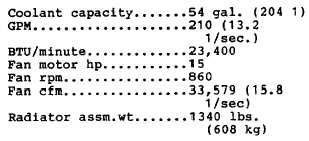TM 5-6115-593-34
NAVFAC P-8-631-34
TO-35C2-3-463-2
required (see figure 17-15). The hot-well tank protects
the cooling system component seals against the
pressure produced by the column of water whose
vertical distance is the height of the radiator above the
engine.
17-56. The tank is divided into two sections by a partial
baffle separating the hot side (engine outlet) from the
cold side (engine inlet). Engine connections to the hot-
well tank must be below the radiator connections to
prevent aeration of the engine. The bottom of the hot-
well tank must be a minimum of 12 inches (30.5 cm)
above the engine coolant outlet. The engine driven
water pump supplies heated coolant from the engine to
the hot side of the tank. The tank provides a quiet area
of low flow velocity with a large surface area to permit
entrained air to dissipate and escape through the vent.
The auxiliary water pump draws water from the hot side
of the tank and pumps it through the radiator and back
to the cold side of the tank where it is tempered to
prevent too low an inlet of the engine driven water
pump.
17-57. The hot-well tank must be capable of containing
60 percent of the coolant system capacity when the unit
is not in operation. The 60 percent figure includes the
radiator and its piping to the tank, an additional 130
percent of the radiator piping capacity must be allowed
for expansion and surge damping. See table 17-5 for
radiator data.
17-58. When the unit is shut down, the radiator coolant
drains into the hot-well tank, whose hot and cold sides
are interconnected by a small opening, thereby reducing
the head of pressure on the engine later pump seals. A
10 psi (7031 kg/m²) maximum external static pressure at
the water pump is held to be the upper limit to provide
for satisfactory water pump seal operation. Static
pressures exceeding this limit may cause fact-type,
spring-loaded seals to lift causing engine coolant
leakage.
17-59. The hot-well tank should be vented and mounted
within 10 feet (3 m) of the engine. To prevent aeration
of the cooling system, the auxiliary pump connected to
the tank must be below normal water level in the tank.
Table 17-5. 500 KW DOD Generator Set Radiator data
Section VII. FUEL SYSTEM
17-60. Since diesel fuel is less volatile than gas or
gasoline, it may be considered a safer fuel from the
standpoint of storage and handling. This is often
reflected in less stringent regulations for placement of
tanks. In some locations, fuel tanks of considerable size
are permitted inside the building or enclosure; however,
planning the installation.
17-61. The very fact that diesel fuel is a safe fuel can
lead to careless installation practices which can result in
poor performance of the engine and generator set.
Diesel fuel may not leak out of an improperly tightened
fitting; however, air can be drawn in through this loose
fitting when the engine is operating.
17-19

